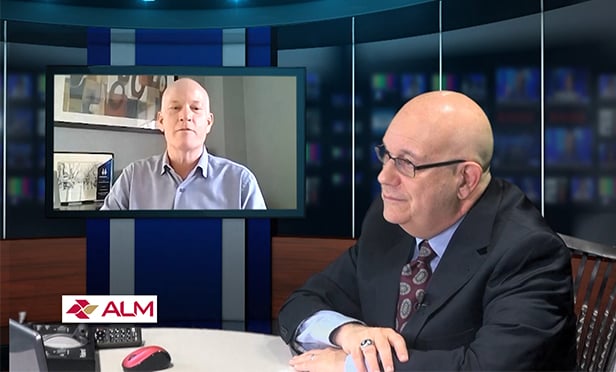From bamboo flooring and carpeting to energy-efficient HVAC systems,numerous environmentally sustainable products have beenmade available recently. This signals a major change from just a fewyears ago when sustainable design was in its infancy in New YorkCity. Still, accumulating enough points for a US Green BuildingCouncil LEED certification remains a challenge.
LEED was created by the USGBC to establish a common standardof measurement for what constitutes a "green" building, evaluatingseveral areas including sustainable sites, water efficiency, energy and atmosphere, materials and resources, and indoor environmental quality. Within these areas, points are awarded, and the number of points a project earns determines the level of certification the building will be awarded. There are four progressive levels of certification:Certified, Silver, Gold and Platinum.
"Five years ago there almost no awareness of any of these issues,"says Dale E. Peterson, principal, Mancini Duffy. "Now, there aremany projects going through the USGBC LEED rating system. Designteams, contractors and manufactures are all developing a body ofexpertise. Many products now are being tailored towards theserequirements. There's been, absolutely, huge growth."
No one knows about the growth of green product demand morethan Eleanor Shtytser, owner of Floor Fantasy, a bamboo flooringbusiness. Installing bamboo flooring satisfies the credit for rapidlyrenewable materials, low-emitting materials, and local regionalmaterials. For the past seven years, Shtytser has attended industryevents and met with anyone expressing even a glimmer of interest inbamboo flooring, toting her cumbersome flooring samples with her.Not many listened.
"Nobody knew bamboo as a product three years ago," saysShtytser. "Now, people already know when I get there why theyshould choose bamboo. We are installing the flooring in residentialand commercial projects, in luxury rentals, and residential facilitiesfor Columbia University. A lot of residential developers in Manhattanand New Jersey are going with bamboo."
Like Shtyster, "many venders are actually now taking the time toread the LEED rating system," says Peterson."They understand how their products have animpact on different credits and are coming to uswith information that's really tailored towardLEED. Will the rating system itself get simpler?Perhaps, but not necessarily in the way manufactureswant. It's not manufacturer-driven.Manufacturers are going to have to work hard insome cases to figure out how their products fitinto a green project."
The carpeting industry has done its homework.Since 1992, the Carpet and Rug Institute hasdeveloped and administered the "Green Label"testing and labeling program, first for carpet andthen for adhesives and cushion materials. Thetesting programs identify low-emitting products,requiring that representative product samplesmeet scientifically established standards. "TheCarpet & Rug Institute has a certification systemcalled Green Seal Plus carpet that feeds directlyinto the USGVC LEED Certification credit system,"says Peterson. "So if you buy a carpet thathas a Green Seal Plus, you can get the LEED pointfor carpet."
But there are still products that need to beinvestigated further to see if the manufacturer orvendor is providing you with a green product orwhat the industry calls "green wash."
"It is basically what the manufacturer says, butthere are ways to verify that the product is whatthey are saying about it," says Erica Godun, anassociate at FXFOWLE and the head ofFXFOWLE's internal sustainability group, 'TeamGreen.' "For wood products there's the ForestStewardship Counsel certification," she adds. "Itcertifies the wood all the way from harvest fromthe forest through the final product. They dochain of custody all the way to the site."
While pricing for some green products arecomparable to non-green products that's not thecase for all products. "Yes, prices are comingdown, but it depends on what the product is,"explains Godun. "For instance, with carpet, youcan get recycled content, recycled backing, lowVOCs in most of the manufacturer's lines at theirnormal pricing. You wouldn't be paying anymore for it. But for FSC certification, those woodsalmost always cost more, because of the processthey go through to get the certification."
Even companies that aren't vying for the LEEDcertification are installing green products to savemoney. Credit Suisse's New York headquarters,located at 11Madison Ave. was recognized last yearby the city and state for installing New York City'slargest ice-storage based air-conditioning system.
"In the past in New York there was a lot ofapprehension—people were saying 'If I'm goingto be green it's going to cost me a lot of money,'"says David R. Pospisil, marketing & communications manager with Trane New York/NewJersey. "We are seeing those rumors fall bythe wayside."
The chiller system allows Credit Suisse tolower their facility's peak energy usage by900kWh, and reduce overall electric usageby 2.15 million kWh. "We are saving $1million in energy costs per year," saysWilliam Beck, managing director, head ofcritical engineering systems at CreditSuisse. "We wanted to go as green as possible,while fully operating the buildingwith no interruption in service."
"When you are able to save as muchmoney as we are seeing at some of thesecorporate jobs, it's going to catch on,"Pospisil says. "You are burning less fossilfuel. You are using less energy. You areusing less natural resources. So the longtermsustainable impact on the environmentis positive. You are delivering highqualityat less and it's helpful to the environment."Trane systems have beeninstalled in buildings for Goldman Sachs,Morgan Stanley, Bloomberg and The DurstOrganization, he adds.
The latest in green product and servicesis green-cleaning of commercial and residentialbuildings. Guardian ServiceIndustries as well as several other cleaningcompanies are using green products andmethods to clean buildings. "The greenmovement is expanding as more and morecompanies embrace environmental sustainability,"says Michael Eisenberg, seniorvice president with Guardian. "Clientresponse to our green initiative has beensimply unbelievable."
Guardian undertook extensive testing ofa variety of products from various suppliersto find the best performing green productsavailable. During that process, it determinedthat the quality and effectiveness ofgreen-cleaning far exceeds the conventionalcleaning methods now in use throughoutthe industry. The benefits of environmentallyresponsible building cleaning servicesinclude improved indoor air quality, lowerwater and air pollution levels, decreasedabsenteeism and increased employee efficiencyand productivity, says Eisenberg.
Guardian's green cleaning services currentlyextends to over 6,000 clients occupyingin excess of 70 million sf of commercialspace in Manhattan and throughout theNortheast, including bank branches, institutions,loft buildings, schools, medicalfacilities, shopping centers and theatres.
Nearly everyone, it seems, is finding away to go green these days.
© Touchpoint Markets, All Rights Reserved. Request academic re-use from www.copyright.com. All other uses, submit a request to [email protected]. For more inforrmation visit Asset & Logo Licensing.






